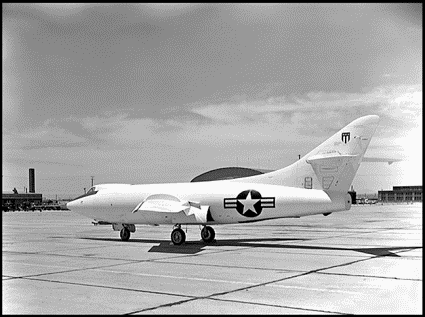

D-558-2 Skyrocket Pilot Shaken -Up After Pulling 6 Gs In His Aircraft
 |
The NACA Douglas D-558-2 Skyrocket's first brush with pitch-up came on 8 August 1949, when test pilot Champine banked into a tight 4-g turn at the modest speed of mach 0.6. Suddenly, without warning, the Skyrocket nosed upward violently-its gravity force recorder indicated that the structure had sustained a momentary 6-g loading. Shaken, Champine applied down elevator, regained control, and landed. Wind-tunnel studies had indicated that swept wing airplanes might experience the pitch-up phenomenon during "accelerated" maneuvers such as high-g turns because of changes in the lifting characteristics of the wing and a decrease in effectiveness of the horizontal tail, particularly if the plane's flight attitude "blanketed" the tail from the oncoming airflow. Champine's flight gave NACA aerodynamicists the first opportunity to study data taken during an actual pitch-up excursion, as well as a new appreciation of the seriousness of the problem. (During takeoff and landing, for example, pitch-up might stall a swept wing airplane and plunge it into the ground before the pilot had a chance to recover; at high speeds, the danger of pitch-up might unduly restrict the maneuvering performance of sweptwing jet fighters.) Subsequently NACA Muroc pilot John Griffith had an even more serious encounter with pitch-up, during a similar 4-g turn. |
He tried to fight the maneuver by forcing the nose down, but Skyrocket's tail effectiveness was low, and the plane commenced rolling and yawing before spasmodically snap-rolling. Griffith recovered handily, but later in the same flight, while performing an approach to stall with the craft's wing flaps and landing gear extended, Skyrocket abruptly pitched up as its tail speed dropped below 210 kilometers per hour; again Griffith tried to fight it, and this time the plane rolled into a spin, dropping 2100 meters before Griffith was able to return it to level flight. NACA Muroc discontinued Skyrocket's pitch-up program in 1950, when the agency and Navy sent the craft back to Douglas to be modified exclusively for rocket propulsion and air-launch from a mother airplane, like the Bell X-1.
| ŠAvStop Online Magazine Contact Us Return To News |